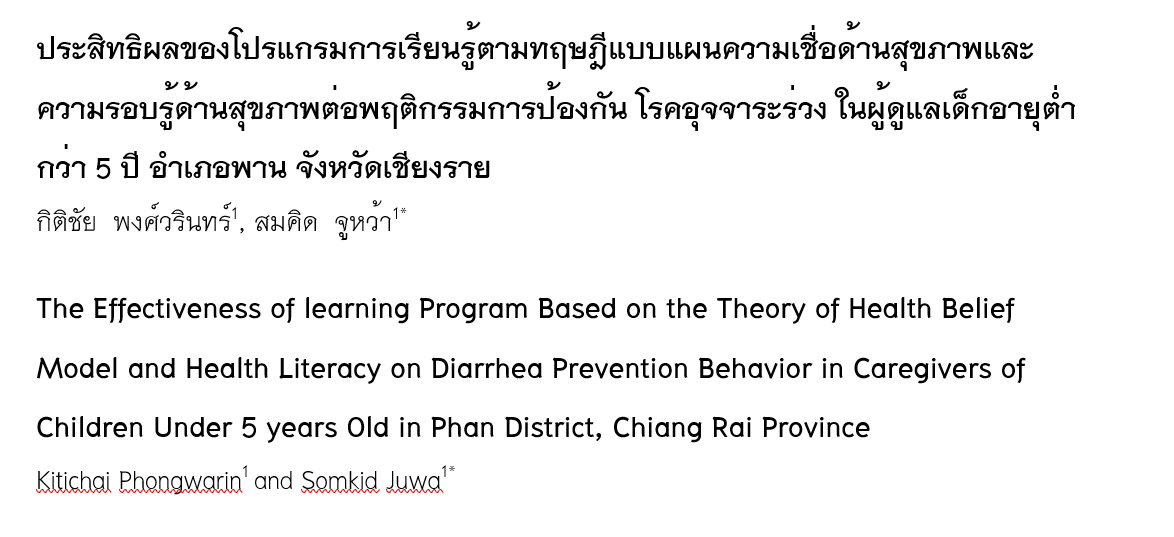The Effectiveness of learning Program Based on the Theory of Health Belief Model and Health Literacy on Diarrhea Prevention Behavior in Caregivers of Children Under 5 years Old in Phan District, Chiang Rai Province
Keywords:
Diarrhea, Caregivers of Children, Health Beliefs, Health Literacy, Diarrhea Prevention BehaviorAbstract
This quasi-experimental study using a two-group pretest–posttest design aimed to study the effectiveness of a learning program based on the theory of health belief model on diarrhea prevention behavior in caregivers of children under 5 years old. The sample group consisted of 72 parents of children under 5 years old from Pan District, Chiang Rai Province. They were divided into experimental and control groups, each comprising 36 individuals. The study duration was 10 weeks, during which data was collected using questionnaires at pre-experiment, post-experiment, and follow-up stages. Data were analyzed using descriptive statistics, Chi-square tests, Independent t-tests, and Repeated Measures ANOVA.
The study results showed that before the experiment, the experimental group and the control group had no statistically significant differences in the average scores of knowledge, health belief perception, literacy, and diarrhea prevention behavior (p > 0.05). After participating in the program and the follow-up period, the experimental group had higher average scores in knowledge, health belief perception, literacy, and diarrhea prevention behavior compared to before the experiment and better than the control group with statistical significance (p < 0.05) (Knowledge F = 95.87, p < 0.01; Health belief perception F = 448.13, p < 0.01; Literacy F = 24.18, p < 0.01 and Diarrhea prevention behavior F = 24.29, p < 0.01). This research concludes that the health belief and knowledge learning program positively influenced diarrhea prevention behaviors in caregivers of children under 5 years old, suggesting its potential applicability in other child care contexts.
References
ขวัญชนก ใจดี, ประภาภรณ์ พรมลุน วิลาวัลย์ อ่อนเหลา ธนูย์สิญจน์ สุขเสริม และ บุษกร สุวรรณรงค์. (2563). พฤติกรรมการป้องกันโรคอุจจาระร่วงในเด็กแรกเกิดถึง 5 ปี ของผู้ปกครองในตำบลนามน อำเภอนามน จังหวัดกาฬสินธุ์. การประชุมวิชาการด้านวิทยาศาสตร์ เทคโนโลยี และนวัตกรรม ครั้งที่ 2 ประจำปี 2563. (น. 486-483). เลย: มหาวิทยาลับราชภัฏเลย.
นาฎอนงค์ แฝงพงษ์, สุวรรณา จันทร์ประเสริฐ และ สมสมัย รัตนกรีฑากุล. (2563). ผลขอลโปรแกรมการพัฒนาความเชื่อด้านสุขภาพของผู้ปกครอง ต่อการรับรู้ และพฤติกรรมการป้องกันโรคมือ เท้า ปาก ในเด็กวัยก่อนเรียนที่ศูนย์พัฒนาเด็กเล็ก. วารสารคณะพยาบาลสาสตร์ มหาวิทยาลัยบูรพา, 2563(3) 113-125.
พินิจ ศรีใส. ( 2553 ). ประสิทธิผลโปรแกรมการเรียนรู้ต้อพฤติกรรมป้องกันโรคอุจจาระร่วงในเด็กอายุต่ำกว่า 5 ปี อําเภอเวียงชัย จังหวัดเชียงราย. (การค้นคว้าแบบอิสระ สาธารณสุขศาสตรมหาบัณฑิต), มหาวิทยาลับเชียงใหม่, เชียงใหม่.
พิเชษฐ สีดาหอม, รัชฏา ฉายจิต, สุบิน พัวศิริ และ ปิยฉัตร พัชรานุฉัตร. (2567). ประสิทธิผลของโปรแกรมส่งเสริมความรอบรู้ด้านสุขภาพช่องปากในผู้ดูแลเด็ก 0-5 ปี อำเภอบัวเชด จังหวัดสุรินทร์. Procedia of Multidisciplinary Research, 2(5), 47.
สุวรรณา มณีวงศ์ ( 2555 ).ผลของโปรแกรมการวางแผนตำหน่ายต่อพฤติกรรมการป้องกันโรคอุจจาระร่วงของผู้ดูแล ในเด็กอายุต่ำกว่า 5 ปี. (วิทยานิพนธ์ปริญญามหาบัณฑิต), จุฬาลงกรณ์มหาวิทยาลัย, กรุงเทพฯ.
สำเนียง ทองทิพย์ และ สมคิด ปราบภัย. (2559). ประสิทธิผลของการสอนแบบอิงประสบการณ์เพื่อการป้องกันโรคอุจจาระร่วงในเด็กก่อนวัยเรียน. Journal of Medicine and Health Sciences, 23(3).
อรวรรณ หล้าสวัสดิ์, สุดาภรณ์ พยัคฆเรือง และ พรรณรัตน์ แสงเพิ่ม.( 2562). ผลของโปรแกรมการสอนต่อความรู้และการปฏิบัติของผู้ดูแลในการดูแลเด็กโรคอุจจาระร่วงเฉียบพลัน. Nursing Science Journal of Thailand, 37(3), 63-78.
อุไรวรรณ เที่ยงสมบูรณ์. (2564). ผลของโปรแกรมกลุ่มช่วยเหลือตนเองสำหรับผู้ดูแลต่อการจัดการพฤติกรรม ก้าวร้าวในเด็กวัยเรียนที่มีความบกพร่องทางการเรียนรู้. วารสารวิทยาลัยราชสุดา, 17(1), 102-119.
Becker, M.H., Maina, L.A., Kirscht, J.P., Heafner, D.P.& Drachman, R.H. (1977). The health belief model and perdiction of dirtary compliance: A field experiment. Journal of Health and Social behavior, 18, 346-348.
Dilruba Nasrin ET. All. (2023). Moderate-to-Severe Diarrhea and Stunting AmongChildren Younger Than 5 Years: Findings from the Vaccine Impact on Diarrhea in Africa (VIDA) Study. Oxford. Clinical Infectious - Diseases®, 76(S1), S41–8.
Harris, D. M. and Guten, S. (1979). Health-protective behavior: An exploratory study. Journal of health and social behavior, 17-29.
Nutbeam, D. (2008). The evolving concept of health literacy. Soc Sci Med, 67(12), 2072- 2078. doi:10.1016/j.socscimed.2008.09.050.
Rosenstock, I.M. (1974). Historical Origins of the Health Belief Model. Health Education Monographs, 2(4), 328-335.
World Health Organization. (2019). Health literacy toolkit for low-and middle-income countries: A series of information sheets to empower communities and strengthen health systems.





